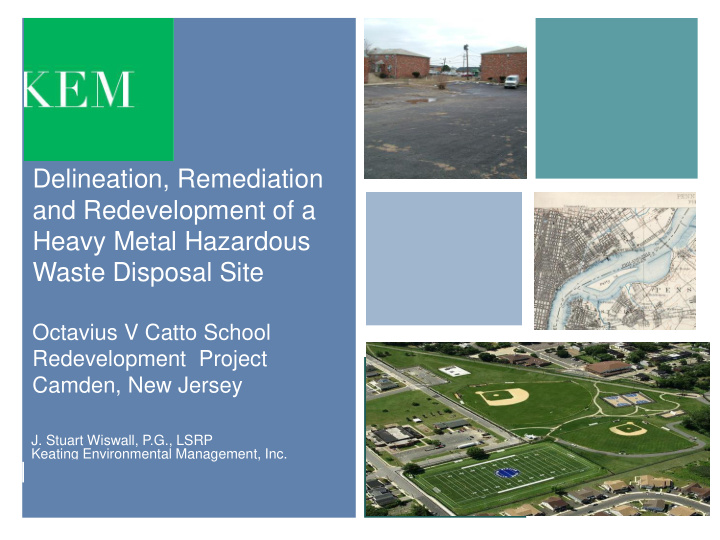



Delineation, Remediation and Redevelopment of a Heavy Metal Hazardous Waste Disposal Site Octavius V Catto School Redevelopment Project Camden, New Jersey J. Stuart Wiswall, P.G., LSRP Keating Environmental Management, Inc.
• Community Revitalization Effort Involving the Collaboration of Public/Private/Regulatory Stakeholders • Redevelopment of a Failing Apartment Complex with a Community Park • Utilized the Triad Approach for Site Assessment Key Elements • Remediation of a Former Pond Used for of the Project Hazardous Waste Disposal and Filled Wirh Historic Fill • On-site Stabilization of Hazardous Waste Prior to Off-site Disposal • Engineering and Institutional Controls Employed to Manage Residual Contamination
3 Site History and Setting
4 1898 Topographic Map
1940 Aerial Photograph
1963 Aerial Photograph Adjacent Pigment Manufacturing Site
1967 Aerial Photograph Apartment Complex Constructed
8 E 2005 Abandoned Manufacturing Plant
9 Site Plan
10 E 2009 Building G – Upper Pond Area
11 E 2009 Building S On Edge of Buried Pond
12 2009 Repaired Settlement Cracks
13 Remedial Objectives
14 Remedial Objectives • Remove Hazardous Waste • Protect Groundwater Quality • Eliminate Direct Exposure Pathway
15 Site Characterization
16 Triad Approach • Systematic Project Planning • Dynamic Work Plan • Real Time Measurement Technologies • GPR/EM • Downhole Conductivity Probe • X-Ray Fluorescence • On-site Laboratory
17 GPR/EM Survey
18 Downhole Conductivity Probe
19 Typical Conductivity Log In From Pond 10000 1000 Peat/Sand Historic Fill Conductivity (mS/m) 100 Sludge 10 1 0 5 10 15 20 25 Depth (feet)
Limits of Historic Fill And Pond Pond Sludge
Identified Contaminants of Concern • Historic Fill Benzo(a)anthracene (46 mg/kg), Lead (6,700 mg/kg), Zinc (21,000 mg/kg) • Sludge Lead (47,000 mg/kg total, 130 ug/L TCLP) • Ground Water • Arsenic (18 ug/L), Cadmium (12 ug/L), Chromium (330 ug/L), Lead (67 ug/L), Cyanide (1,570 ug/L)
Contaminants of Concern • TCLP analysis; lead leached above the toxic characteristic hazardous waste threshold in some sludge samples • SPLP Analysis: Potential for lead and arsenic to leach from fill above GWQS
23 Remedial Approach • Excavate/Stockpile Historic Fill • Dewater Pond, Treat Groundwater and On-site Infiltration • Excavate Sludge, Stabilize, Off-site Disposal • Install Clean Soil Buffer, Place Historic Fill, Install Clean Soil Cap • Establish Ground Water Classification Area and Deed Notice
24 S Remediation
25 Remediation Steps • Building Decontamination and Removal • Foundation Removal • Excavation/Stockpiling of Historic Fill from Pond Area • Excavation and Stabilization of Sludge • Install Clean Soil Buffer • Replace Historic Fill • Install Cap • Establish CEA
26 February 2005
27 Removing Foundations
28 Bottles in Foundation Concrete
29 Dewatering Wells Installed
30 Water Treatment System
31 Historic Fill Excavation From Pond
32 RRetaining Wall
33 Paint Waste in Historic Fill
34 Historic Fill Stockpile
35 Pond Sludge Layer
36 Excavating Sludge
37 Sludge Treatment Area
38 A Part of the Treatment Area
39 Pigment Layering in Sludge
40 Pond Bottom
41 Confirmation Sampling of Pond Bottom
42 Placing Clean Soil Buffer
43 Waste Stabilization • Stabilization Chemical - Inorganic Mixture of Magnesium Oxide and Calcium Phosphate • Attempt to use phosphoric acid-based product unsuccessful; Reaction generated H2S • Pre-remediation bench testing to determine treatment ratio for lead • Composite sampling of each waste pile to determine lead concentration • Product delivered in bulk and mixed with excavator • Post treatment composite sampling to verify results
44 Chemical Delivery
45 Mixing Chemical
46 Treatment Near Completion
47 Non-Hazardous Waste Transported Off Site
48 Placing Fill in Excavation
49 Separation Fabric between Fill and CAP
50 Stockton Station Park
51 Questions?
52 THANK YOU Contact Information Name: Stuart Wiswall, P.G., LSRP Keating Environmental Management, Inc. Phone: 484-876-2197 E-mail: swiswall@kempartners.com
Recommend
More recommend